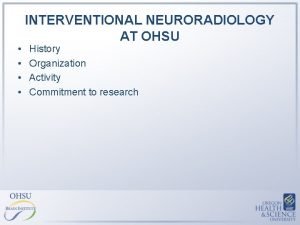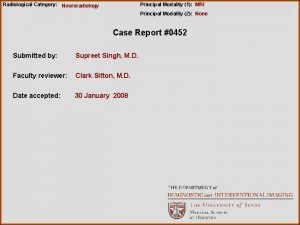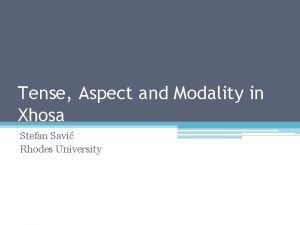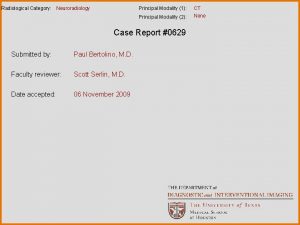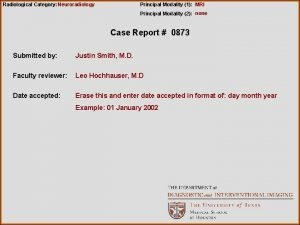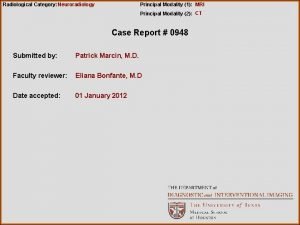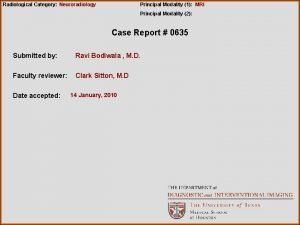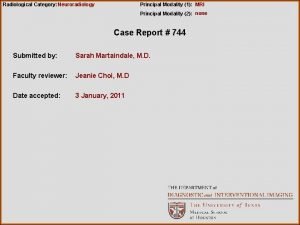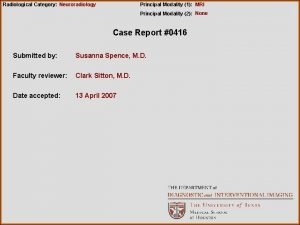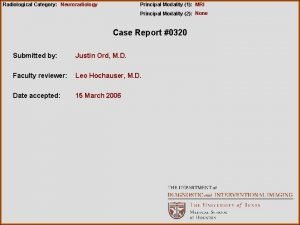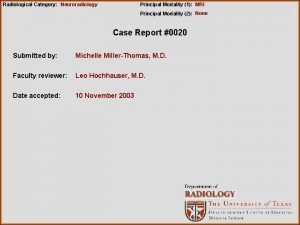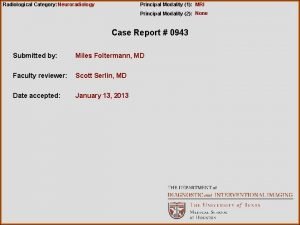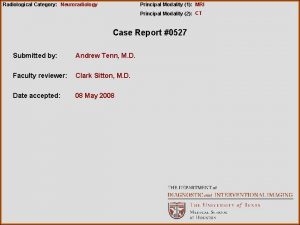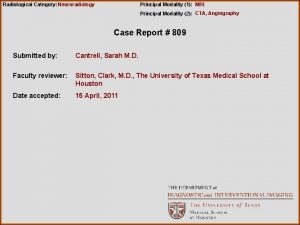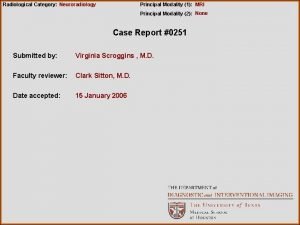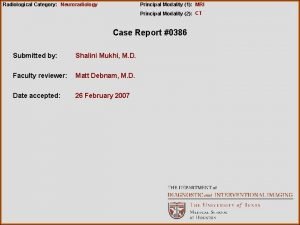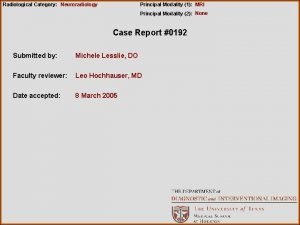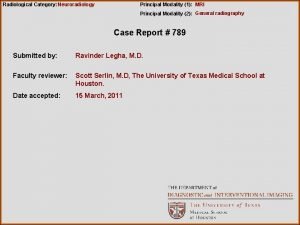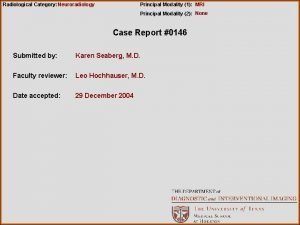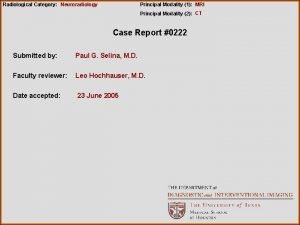Radiological Category Neuroradiology Principal Modality 1 MRI Principal





















- Slides: 21

Radiological Category: Neuroradiology Principal Modality (1): MRI Principal Modality (2): CT Case Report 0967 Submitted by: Cantrell, Sarah M. D. Faculty reviewer: Serlin, Scott, M. D. Date accepted: 15 February 2013

Case History 50 yo male with past medical history of seizures and bipolar disorder found unresponsive

Radiological Presentations B A Axial CT (A, B) images of the brain

Radiological Presentations A C B D Axial MR T 1 pre (A, B), and post T 1 C+ (C, D) images of the brain

Radiological Presentations A C B D Axial MR T 2 (A, B), and DWI (C, D) images of the brain

Findings and Differentials Findings: The most salient feature within all images is lesions within the periventricular and subcortical white matter which do not exert significant mass effect on the surrounding parenchyma

Radiological Presentations A B Axial CT (A, B) images of the brain demonstrate hypoattenuation within the periventricular and subcortical white matter without mass effect on the adjacent parenchyma

Radiological Presentations A B C D (A, B) Axial MR T 1 precontrast images demonstrate T 1 hypointense and isointense lesions within the periventricular and subcortical white matter. (C, D) Axial postcontast T 1 C+ images of the brain demonstrate incomplete contrast enhancement or “horseshoe” enhancement ( ) of hypointense lesions within the periventricular and subcortical white matter

Radiological Presentations A C B D (A, B) Axial MR T 2 images demonstrate T 2 hyperintense lesions which do not exert significant mass effect on the surrounding parenchyma. (C, D) Axial DWI images demonstrate rim of restricted diffusion surrounding the lesions

Findings and Differentials Findings: The most salient feature within all images is lesions within the periventricular and subcortical white matter which do not exert significant mass effect on the surrounding parenchyma Differentials: • Glioblastoma multiforme • Multiple metastases • ADEM • Multifocal brain abscess • Tumefactive multiple sclerosis

Discussion Glioblastoma multiforme • • • Definition: WHO Grade IV astrocytoma Location: – Most common: supratentorial brain (butterfly lesion) – Brainstem and cerebellum less common Imaging: – Vasogenic edema with significant mass effect on the surrounding parenchyma and midline shift – T 1 +C: Complete ring enhancement surrounding a necrotic core – DWI: most do not restrict diffusion – T 2/FLAIR: heterogenous lesion with fluid filled necrotic core – T 2*GRE: may contain blood products with blooming

Discussion Glioblastoma multiforme T 1+C DWI FLAIR Axial postcontrast T 1 WI demonstrate “butterfly” lesion crossing the corpus callosum which restricts diffusion. FLAIR images demonstrates heterogenous hyperintense and infiltrating tumor with surrounding vasogenic edema and mass effect with effacement of the right lateral ventricle.

Discussion Multiple metastases • • • Etiology: lung, breast and melanoma metastases most common Location: – Most common: supratentorial brain, classically at the gray-white junction Imaging: – Typically located at the gray-white junction – Variable enhancement, T 1 and T 2 signal intensity depend on primary tumor – DWI: most do not restrict diffusion

Discussion ADEM • • Etiology: autoimmune mediated acute demyelination following vaccination or viral infection, More common in children, males>females Location: – Periventricular and subcortical white matter, can involve the brainstem and spinal cord – Sparing of the callososeptal interface Imaging: – Asymmetric confluent T 2/FLAIR hyperintensities involving the peripheral white matter and subcortical U-fibers – DWI: restricted diffusion portends worse prognosis – T 1 C+: Enhancement variable Axial T 2/FLAIR demonstrates FLAIR hyperintensity throughout the subcortical white matter and within the left middle cerebral peduncle

Discussion Brain Abscess • • Etiology: Embolic hematogenous spread versus postsurgical/post-traumatic spread versus direct spread of infection within the head and neck (paranasal sinuses, skin) More common in children, males>females Location: – Supratentorial brain most common Imaging: 4 phases – Early cerebritis: T 1 hypo/isointense; T 2 hyperintense; DWI restricts diffusion; T 1 C+ patchy enhancement – Late cerebritis: T 1 hyperintense rim; T 2 hypointense rim; DWI restricts diffusion; T 1+C irregular rim enhancement – Early capsule: T 1 hyperintense rim; T 2 hypointense rim; DWI restricts diffusion; T 1+C thin walled rim enhancement – Late capsule: overall mass effect decreases; T 1 hyperintense rim; T 2 hypointense rim; T 1+C capsule thickens Postsurgical abscess after repair of multiple facial fractures. CECT demonstrates thick irregular enhancing capsular rim within the left frontal lobe with surrounding vasogenic edema and mass effect on the adjacent parenchyma with midline shift

Discussion Tumefactive Multiple Sclerosis • • • Etiology: Autoimmune T-cell mediated demyelinating process Demographics: Caucasian, 20 -40 yrs, F>M Clinical Course: Unlike typical relapsing-remitting and secondary progressive variants of multiple sclerosis, patients with tumefactive multiple sclerosis typically present with signs/symptoms of a mass lesion and do not go on to develop multiple sclerosis Mimicks tumor in both imaging and clinical presentation Location: – Typically multiple sclerosis presents as T 2/FLAIR hyperintense lesions within the periventricular/subcortical white matter and subcortical U-fibers. Tumefactive multiple sclerosis, however, may present as a solitary mass lesion within the cerebral hemispheres, mimicking tumor. Histology: – Macrocytic infiltration with reactive astrocytosis – Hypercellular/reactive astocytes may mimic neoplasm histologically – Eventually, loss of myelin with preservation of astrocytes

Discussion Tumefactive Multiple Sclerosis • A Following admission and imaging, patient was taken to OR for biopsy. – Histology: macrocytic infiltration within parenchyma and surrounding blood vessels with severe reactive astrocytes • (A) In the white matter, infiltration by macrophages both in the parenchyma and around the blood vessels is present. Severe reactive astrocytosis is seen in the white matter • (B) ABC immunoperoxidase stain for neurofilament protein shows preservation of axons B Special thanks to Dr. Sosos Papasozomenos for pathologic correlation

Discussion Tumefactive Multiple Sclerosis • Imaging: –Large mass lesions with little mass effect on the surrounding parenchyma –Centered in white matter but may extend to involve gray matter –T 2: hyperintense –DWI: restricts diffusion within the periphery –T 1: hypo/isointense –T 1+C: • incomplete horseshoe ring enhancement • enhancing margin of the lesion abuts the white matter and represents active demyelination

Diagnosis Tumefactive Multiple Sclerosis

Diagnosis Why not GBM? Images demonstrate little mass effect on surrounding parenchyma and incomplete rim enhancement. GBM characteristically exerts mass effect on surrounding parenchyma with complete rim enhancement. Why not multiple metastases? Metastases have variable presentation and correlation with history of primary malignancy did not reveal any known cancer diagnosis in our patient. Additionally, lesions are not characteristic location of metastases at the gray/white junction. Why not ADEM? Although ADEM is a white matter process typical appearance is not a mass lesion as in our patient. Why not brain abscess? Images demonstrate little mass effect on surrounding parenchyma and incomplete rim enhancement. Abscess characteristically exerts mass effect on surrounding parenchyma with complete rim enhancement.

References Dagher AP, Smirniotopoulos J. Tumefactive demyelinating lesions. Neuroradiology 1996 ; 38: 560 – 565 Given CA, Stevens SB, Lee C The MRI Appearance of Tumefactive Demyelinating Lesions. AJR 2004 vol. 182 no. 1 195 -99. He J, Grossman RI, Ge Y, Mannon LJ. Enhancing patterns in multiple sclerosis: evolution and persistence. AJNR 2001 ; 22: 664 – 669 Kepes JJ. Large focal tumor-like demyelinating lesions of the brain: intermediate entity between multiple sclerosis and acute disseminated encephalomyelitis? a study of 31 patients. Ann Neurol 1993 ; 33: 18 – 27 Masdeu JC, Moreira J, Trasi S, Visintainer P, Cavaliere R, Grundman M. The open ring: a new imaging sign in demyelinating disease. J Neuroimaging 1996; 6: 104 – 107 Paley RJ, Persing JA, Doctor A, et al. Multiple sclerosis and brain tumor: a diagnostic challenge. J Emerg Med 1989 ; 7: 241 – 244 www. statdx. com
 Ohsu neuroradiology
Ohsu neuroradiology Erate category 2 eligible equipment
Erate category 2 eligible equipment Center for devices and radiological health
Center for devices and radiological health National radiological emergency preparedness conference
National radiological emergency preparedness conference Radiological dispersal device
Radiological dispersal device Tennessee division of radiological health
Tennessee division of radiological health Mri principal
Mri principal Epistemic modality
Epistemic modality Imaging modality
Imaging modality Data modeling fundamentals
Data modeling fundamentals Modality
Modality Modality in software engineering
Modality in software engineering Pacs modality workstation
Pacs modality workstation Modality in software engineering
Modality in software engineering Lexical vs auxiliary verbs
Lexical vs auxiliary verbs Sensory vs somatic
Sensory vs somatic High modality examples
High modality examples Epistemic modality
Epistemic modality Cardinality and modality
Cardinality and modality Diplode
Diplode Tom arbuthnot
Tom arbuthnot Sodality vs modality
Sodality vs modality
